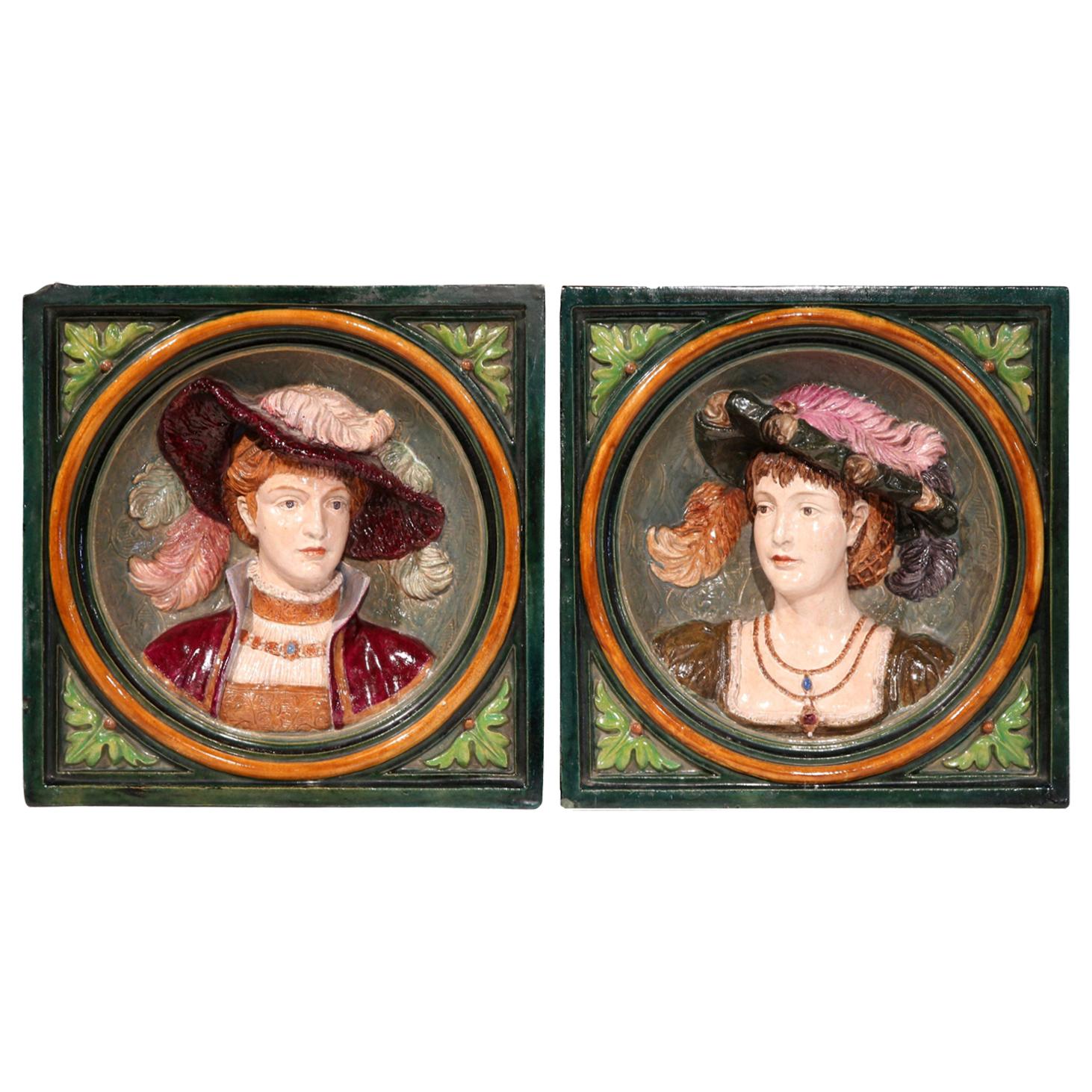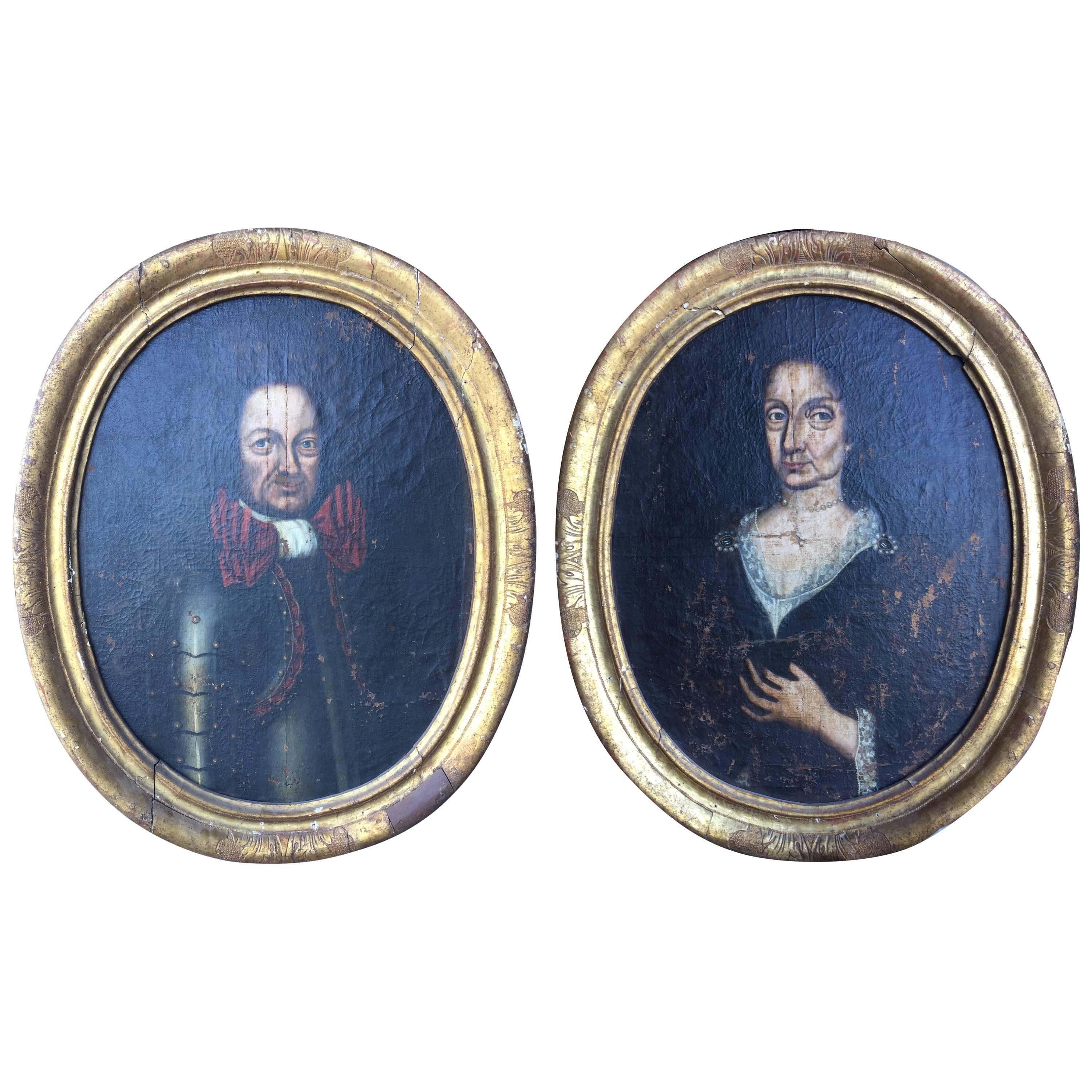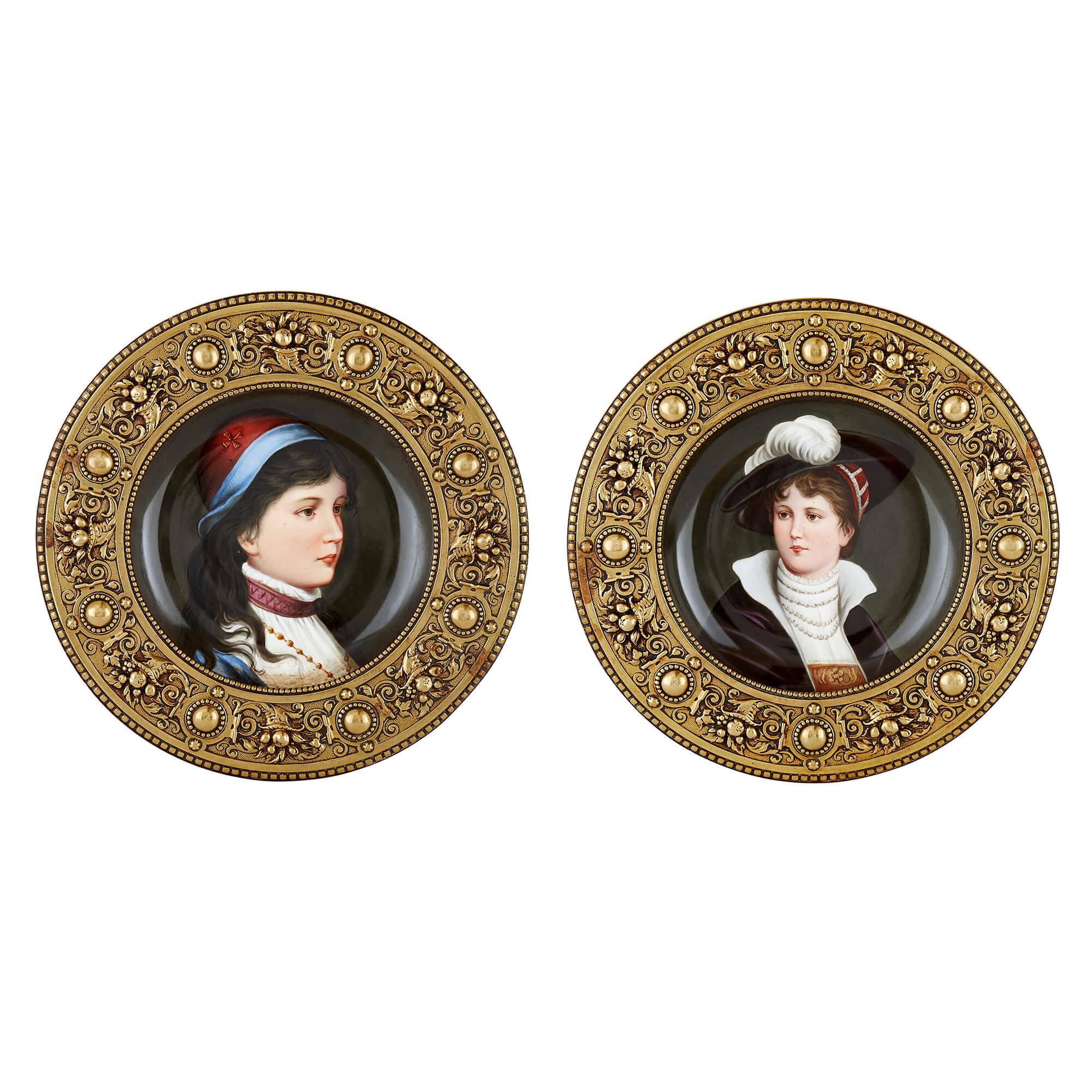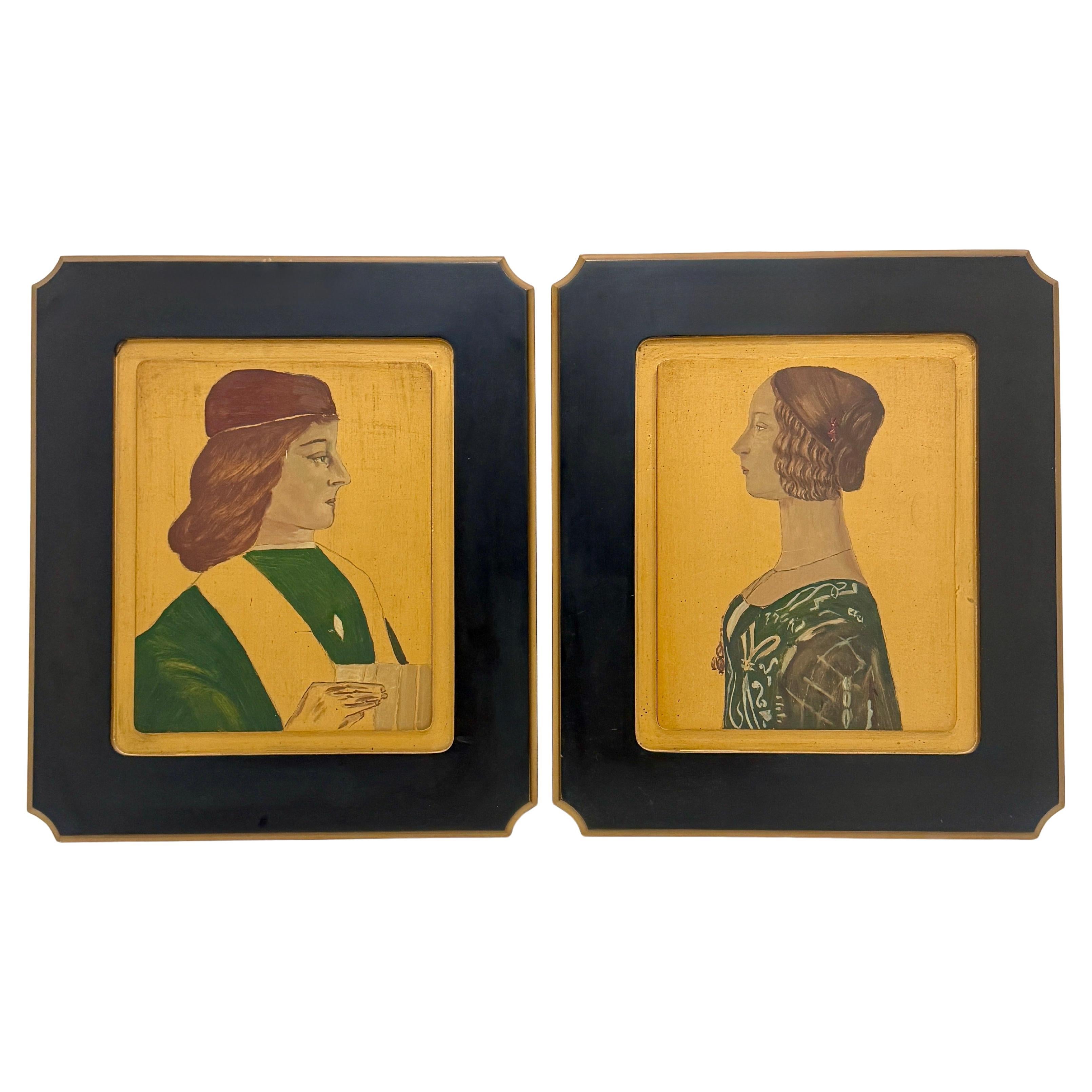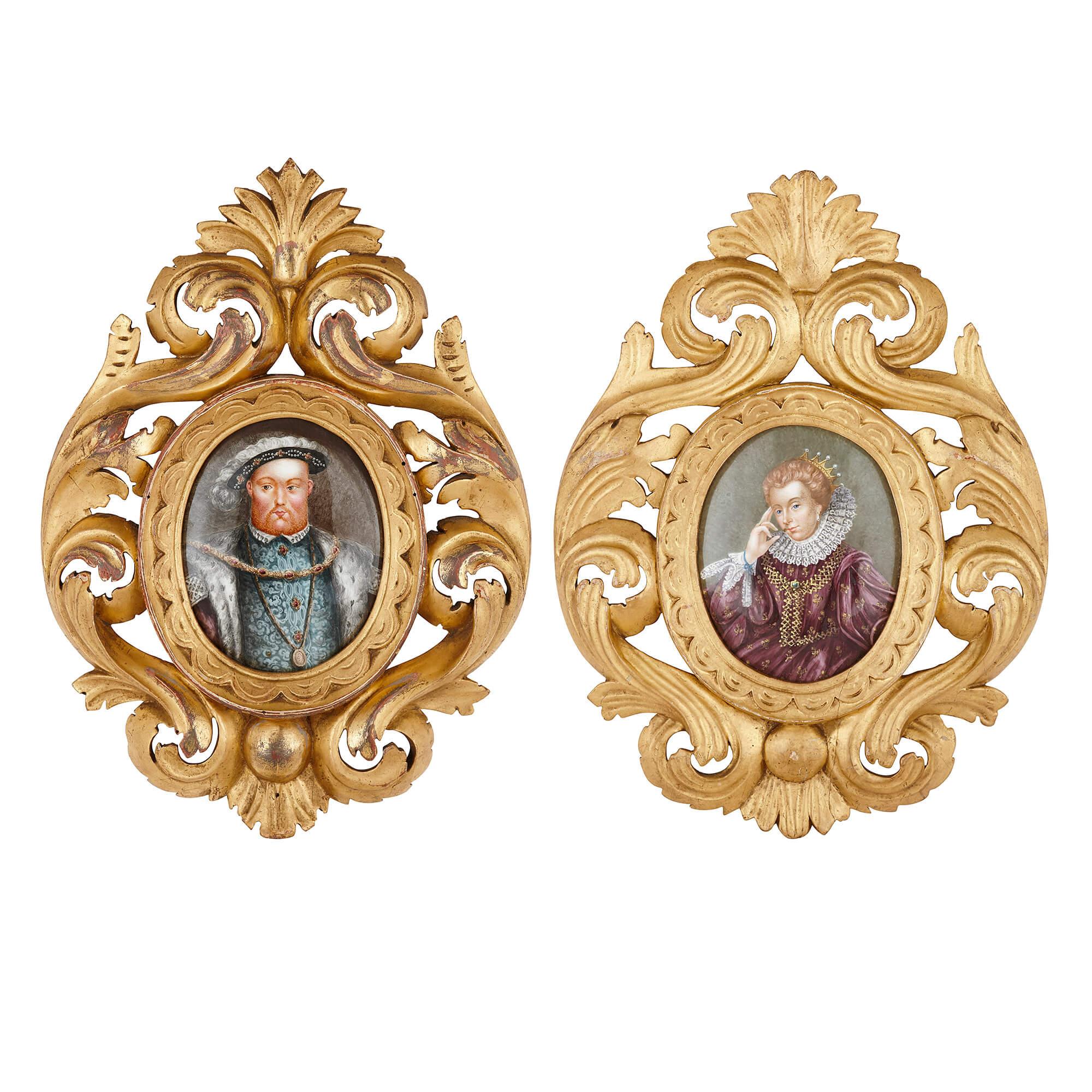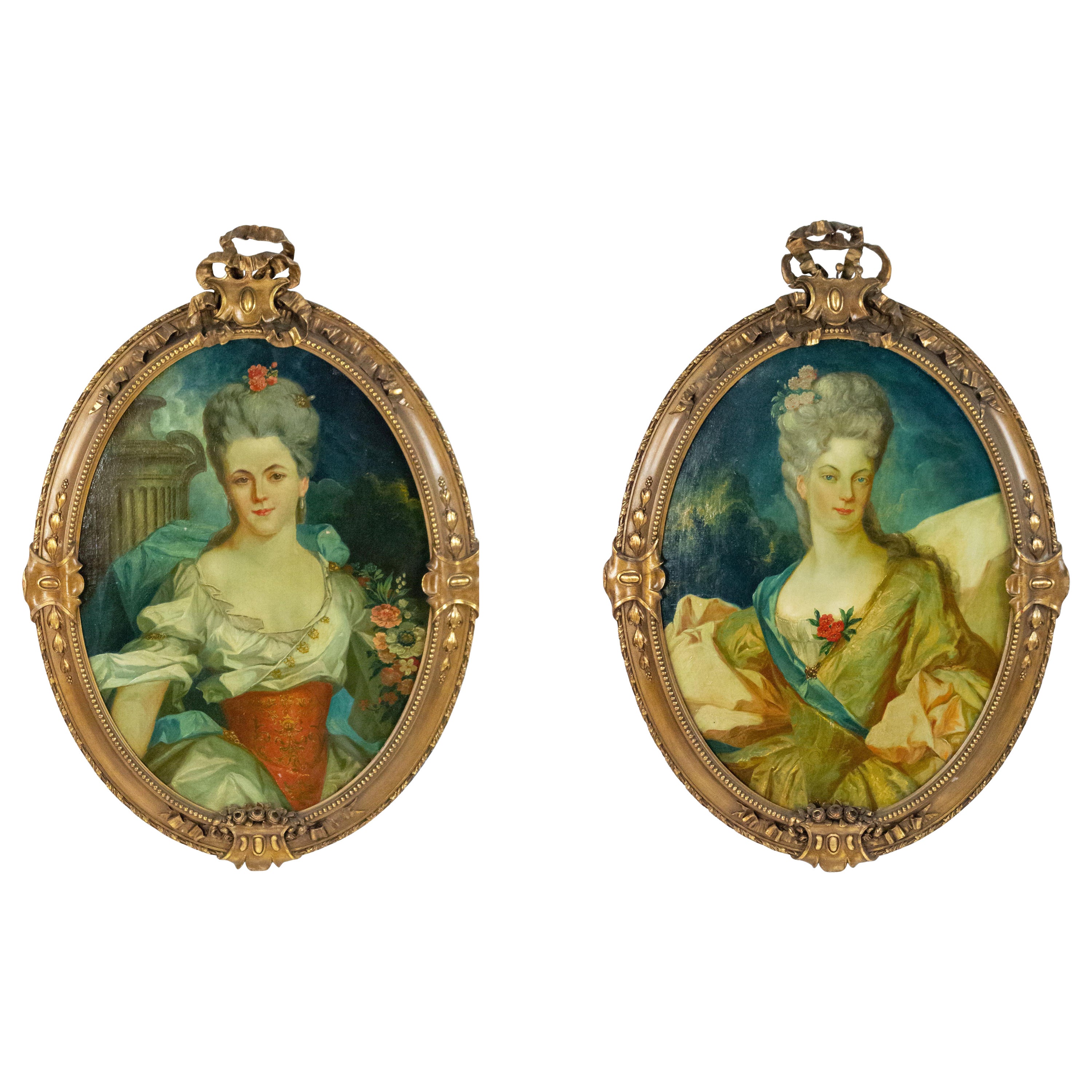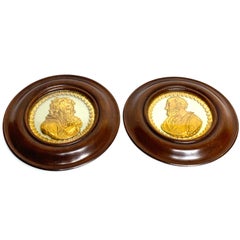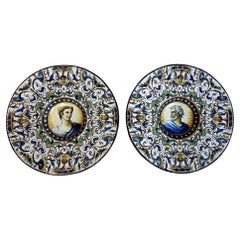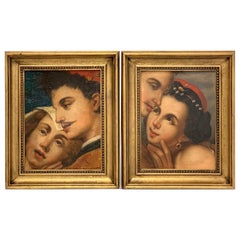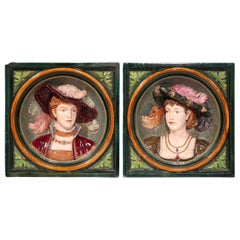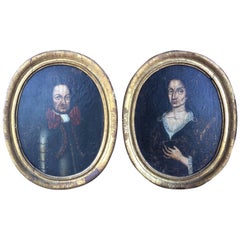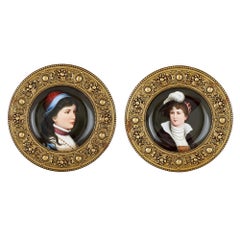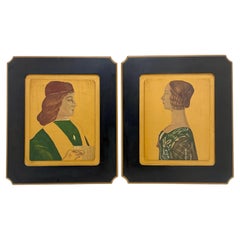Items Similar to Pair 18th Century Eleanora & M. Magdalena Medici Wax Portraits On Slate
Want more images or videos?
Request additional images or videos from the seller
1 of 10
Pair 18th Century Eleanora & M. Magdalena Medici Wax Portraits On Slate
$4,800per set
£3,686.19per set
€4,224.33per set
CA$6,757.21per set
A$7,569.57per set
CHF 3,937.12per set
MX$92,333.17per set
NOK 50,124.76per set
SEK 47,264.07per set
DKK 31,529.26per set
About the Item
Eleanora & M. Magdalena Dei Medici Wax Portraits on Slate
Measures: 4.5" DA
18th Century or Earlier Wax Portraits of Eleonora de' Medici and Maria Magdalena de' Medici in Ormolu Frames with Convex Glass
This exquisite pair of wax portrait reliefs on slate depicts Eleonora de' Medici (1567–1611) and Maria Magdalena de' Medici (1575–1626), two notable women of the illustrious Medici family. Each portrait is housed in an elegant ormolu (gilt bronze) frame with convex glass, measuring 4.5 inches in diameter. The finely detailed wax portraits showcase vibrant period attire adorned with delicate jewelry, ruffled collars, and carefully coiffed hair, reflecting the noble status and refined aesthetic of the late Renaissance.
The wax medium, expertly modeled, demonstrates a sophisticated artistry popular in the 18th century, though these pieces could potentially be earlier, given the subject matter and style. Wax portraiture on slate became fashionable during the 18th century as part of the neoclassical revival, celebrating Renaissance figures such as the Medici family. The ormolu frames and convex glass suggest these works were highly valued, designed for display in an elite interior setting.
Eleonora de' Medici, daughter of Grand Duke Francesco I de' Medici and Joanna of Austria, was known for her patronage of the arts and refined taste. Her marriage to Vincenzo I Gonzaga, Duke of Mantua, positioned her as a key figure in Italian court life, where she played a significant role in cultural diplomacy. Her younger sister, Maria Magdalena de' Medici, became Grand Duchess of Tuscany through her marriage to Cosimo II de' Medici. Maria Magdalena acted as regent for her son, Ferdinando II, and was influential in maintaining Medici power during a critical period in Florentine history.
This rare pair of portraits offers collectors an exceptional opportunity to own works that honor two prominent Renaissance women, encapsulated in finely preserved frames that highlight the enduring legacy of the Medici family.
Further Notes:
Eleonora de' Medici (1567–1611) and Maria Magdalena de' Medici (1575–1626) were notable members of the powerful House of Medici, a family that played a pivotal role in the political, cultural, and artistic life of Renaissance Florence and Tuscany. As daughters of Francesco I de' Medici, Grand Duke of Tuscany, and Joanna of Austria, they were central figures in European aristocracy, often involved in strategic marriages and alliances that shaped the political landscape of the time.
Eleonora de' Medici (1567–1611)
Eleonora, known for her beauty and intelligence, was a Medici princess who embodied the sophistication and influence of her family. In 1584, she married Vincenzo I Gonzaga, Duke of Mantua, aligning the Medici family with the Gonzagas, another significant ruling house in Italy. This union strengthened the political power of both families. Eleonora's marriage brought cultural exchanges between Florence and Mantua, influencing the arts, literature, and music. She was known for her patronage of the arts and her refined taste, typical of the Medici women who played essential roles in promoting Renaissance culture.
Maria Magdalena de' Medici (1575–1626)
Maria Magdalena was equally significant, though her influence was primarily within the Tuscan court. In 1608, she married Cosimo II de' Medici, her cousin and the Grand Duke of Tuscany. As Grand Duchess of Tuscany, Maria Magdalena played a vital role in court life and politics. She was a patron of science and the arts, supporting figures like Galileo Galilei, who dedicated some of his works to the Medici family. Maria Magdalena also acted as regent for her son, Ferdinando II de' Medici, after Cosimo II's death, demonstrating her political acumen and leadership.
The Medici Legacy
The Medici women, including Eleonora and Maria Magdalena, were more than just symbols of dynastic alliances; they were patrons of the Renaissance, fostering the growth of the arts and sciences that defined the era. Their portraits, such as the wax bas-reliefs on slate, celebrate their enduring legacy as cultural icons and political influencers. These portraits highlight not only their regal appearances but also their roles in shaping the artistic and intellectual heritage of Tuscany and beyond.
- Dimensions:Height: 0.25 in (6.35 mm)Diameter: 4.5 in (11.43 cm)
- Sold As:Set of 2
- Style:Baroque (Of the Period)
- Materials and Techniques:
- Place of Origin:
- Period:
- Date of Manufacture:18th Century or Older
- Condition:Wear consistent with age and use. Minor losses.
- Seller Location:West Palm Beach, FL
- Reference Number:Seller: SDHU5T14561stDibs: LU2592338828482
About the Seller
5.0
Platinum Seller
Premium sellers with a 4.7+ rating and 24-hour response times
Established in 1996
1stDibs seller since 2017
1,405 sales on 1stDibs
Typical response time: <1 hour
- ShippingRetrieving quote...Shipping from: Highpoint , NC
- Return Policy
Authenticity Guarantee
In the unlikely event there’s an issue with an item’s authenticity, contact us within 1 year for a full refund. DetailsMoney-Back Guarantee
If your item is not as described, is damaged in transit, or does not arrive, contact us within 7 days for a full refund. Details24-Hour Cancellation
You have a 24-hour grace period in which to reconsider your purchase, with no questions asked.Vetted Professional Sellers
Our world-class sellers must adhere to strict standards for service and quality, maintaining the integrity of our listings.Price-Match Guarantee
If you find that a seller listed the same item for a lower price elsewhere, we’ll match it.Trusted Global Delivery
Our best-in-class carrier network provides specialized shipping options worldwide, including custom delivery.More From This Seller
View AllPair of Antique English Grand Tour Portrait Plaques "Hera & Rhodus"
By Hancock & Son
Located in West Palm Beach, FL
Pair of antique English grand tour portrait 12" Plaques, "Hera & Rhodus". Both by Hancock A Son, Worcester with remnants of exhibition labels, in l...
Category
Antique Late 19th Century English Grand Tour Porcelain
Materials
Composition
$1,200 Sale Price / set
20% Off
Pair of English Regency Framed Ormolu Portrait Plaques of St. Paul & Socrates
Located in West Palm Beach, FL
Pair of English Regency framed ormolu portrait plaques of St. Paul & Socrates
Exceptional quality and casting, beautifully framed with convex glass.
Each plaque is mounted in a circu...
Category
Antique 19th Century English Regency Wall-mounted Sculptures
Materials
Ormolu
$1,421 Sale Price / set
25% Off
A Pair of 19th C Italian Renaissance Style Majolica Portrait Chargers
By Cantagalli
Located in West Palm Beach, FL
Pair of 19th-century Italian Renaissance Style Majolica portrait chargers
Style of Cantagalli: One dish has two minor 'flea-bite' chips to the back, not...
Category
Antique 19th Century Italian Renaissance Ceramics
Materials
Pottery
Near Pair of Old Master Romantic Portraits
Located in West Palm Beach, FL
Near pair of old master romantic portraits
Each one with two hugging period dressed couples, unsigned
Measures: Male facing right
8" x 10.5" can...
Category
Antique 19th Century European Paintings
Materials
Giltwood
$938 Sale Price / set
24% Off
Pair of 18th C. Italian Baroque Neapolitan Crèche Leather Figures of Merchants
Located in West Palm Beach, FL
Pair of 18th-Century Italian Baroque Neapolitan Crèche Figures of Merchant Men in Leather
A rare and expressive pair of 18th-century Italian Baroque crèche figures, likely originati...
Category
Antique 18th Century Italian Baroque Figurative Sculptures
Materials
Leather, Wood
Pair of Antique French Bronze Appliqués Depicting Art and Music
Located in West Palm Beach, FL
Pair of antique French bronze appliqués depicting art and music, each one finely cast draped putto one holding an artists palette the other a lute.
Art measures: 10.5" H x 6" W
Mus...
Category
Antique 19th Century French Baroque Revival Figurative Sculptures
Materials
Bronze
$476 Sale Price / set
20% Off
You May Also Like
Pair of 19th Century French Hand Painted Ceramic Barbotine Figural Wall Plaques
Located in Dallas, TX
Embellish a wall or shelf with this elegant pair of antique, hand painted Majolica wall hanging plaques. Crafted in France, circa 1880, the ceram...
Category
Antique Late 19th Century French Renaissance Decorative Art
Materials
Ceramic, Majolica
Pair of Vintage Framed Portraits, c. 19th Century
Located in Napa, CA
Pair of vintage oil paintings, circa 19th century in gilded frames.
Category
Antique 19th Century Paintings
Materials
Canvas, Wood, Giltwood
$14,000 / set
Pair of framed antique circular porcelain portrait plaques
Located in London, GB
These two porcelain plaques have been expertly painted to show portraits of a young girl and a young boy, and are set within circular brass frames.
The girl wears a light blue coat...
Category
Antique 19th Century Austrian Paintings
Materials
Brass
Pair of Hand Painted Medici Portraits on Carved Wood Panels, c. 1930's
Located in Fort Lauderdale, FL
Pair of early 20th Century Medici portraits hand-painted on carved wood wall plaques. The handmade panels have a black lacquered finish with gold leaf details and feature rounded co...
Category
Vintage 1930s American Renaissance Contemporary Art
Materials
Wood
Two Limoges Enamel Paintings Including Portrait of Henry VIII
By Hans Holbein
Located in London, GB
These exquisite portrait plaques were made in the French town of Limoges, which is renowned for the fine quality of its enamel wares. The panels have been painted with oval, half-length portraits of British Tudor monarchs...
Category
Antique 19th Century French Renaissance Revival Paintings
Materials
Enamel
Pair of French Louis XV Style 19th Century Ladies Portraits
Located in Queens, NY
Pair of French Louis XV style gilt framed oval oil paintings portraits of 18th Century ladies (18/19th century).
Category
Antique 19th Century Louis XV Paintings
Materials
Giltwood
More Ways To Browse
Wax Model
Medici Furniture
De Medici
Antique Slate
18th Century Icon
Duchess Furniture
Italian Slate
Antique Duchess
Antique Convex Glass
Tuscan Renaissance
Antique Ruffled Glass
18th Century Portrait Pair
Neoclassical Bas Relief
Antique Florentine Glass
Antique Wax Portrait
Rare Tuscan
Florentine Gilt Frame
Medici Jewelry
